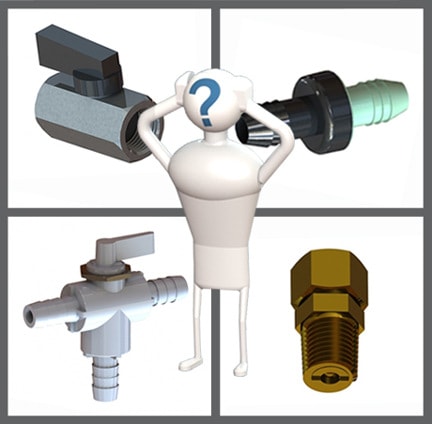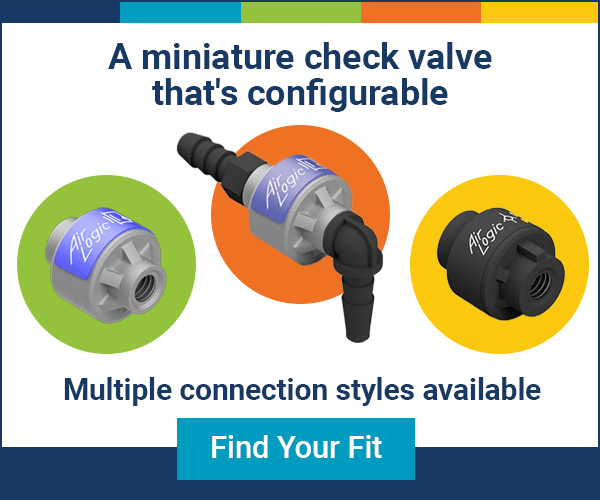Five Tips for Selecting the Right Valve
Choose the right valve means answering key questions first
Published: August 1, 2018
Last updated: December 30, 2021
 Knowing what makes a valve the right choice
Knowing what makes a valve the right choice
Valves control gas and liquid flow in almost every process and system. As common as they are, choosing the right valve can sometimes be time consuming and confusing.
Begin valve selection by first gathering some basic information on system performance requirements. Knowing this will make it easier to find the right valve. The five tips in this article focus on how to match valve features with these requirements.
Tip 1 – Valve size and type
Choose the right valve type. Every valve needs to perform one or more basic functions:
- Shut off flow
- Divert flow
- Mix flow
- Pressure relief
- Backflow prevention
- Adjust flow
 Function determines the design of standard valve types. These are some of the most common valve types:
Function determines the design of standard valve types. These are some of the most common valve types:
- Check valves
- Ball valves
- Needle valves
- Metering valves
- Toggle valves
- Stopcocks
- Relief valves
- Regulators
- Pinch valves
Properly sizing the valve is also important. The right valve choice means matching the valve’s size to expected flow through the system.
Common Valve Types at VMA, Valve Manufacturers Association of America
How to Select the Right Valve (with Pros and Cons) at Indelac Controls
Tip 2 – Materials of construction
Know the chemical compatibility requirements. The valve materials need to be compatible with the gases or liquids flowing through it. Plastic valves usually resist harsh or corrosive chemicals better than metal valves.
Miniature Ball Valves: Plastic, Brass or Stainless Steel? at ISM, Industrial Specialties Mfg.
Chemical Compatibility Chart at ISM, Industrial Specialties Mfg.
Tip 3 – Performance requirements
Determine the pressure and temperature requirements. Find out both the temperature and pressure ranges where the valve will be installed. Metal valves tend to withstand higher temperatures and pressures than plastic valves. Metal valves are also usually best for pressurized gases. This is because they tend to be stronger than plastic valves.
A Selection Criterion for Pump and Valve Reliability at Processing Magazine
Tip 4 – Check valves have special requirements
Be sure the new check valve will work as expected. Look at the response time needed as well as the cracking pressure required to open the valve.
Another consideration is normally closed vs normally open. There are basic check valve designs that require positive downstream pressure to open. These are usually referred to as normally closed check valves. There are other designs that require a positive backpressure to close. These are usually called normally open check valves. An appropriate choice between these two can improve check valve reliability. It is usually best to base this decision on whether the valve is usually open more or usually closed more during normal system operation.
Some check valve types may not work properly if mounted vertically instead of horizontally. Flow direction (upwards vs downwards) and fluid density both matter for check valve designs that can be mounted vertically.
Checking Out Check Valves – An Introduction at ISM, Industrial Specialties Mfg.
Tip 5 –Maintenance
Don't forget to consider ongoing maintenance. Any valve choice should include attention to maintenance requirements. This is important for both valve reliability and application stability.
A good example of this are ball valves. They resist clogging, jamming or malfunctioning. But they are not suitable for adjusting flow. Using them to control flow can lead to leaking or premature failure.
Valve connection type affects the ease and speed of repair or replacement. Each connection type (threaded, barbed, push-in, Luer, and so on) has its pros and cons.
Plant and Equipment Maintenance at HSE, Health and Safety Executive
Knowing where to start makes valve choice faster and easier
There it is. Knowing particular information beforehand, makes choosing the right valve easier and more certain. There will always be complications like application requirements, operating conditions and chemical compatibility. Starting with basic valve requirements will simplify and speed up valve selection:
- Valve size and type
- Materials of construction
- Performance requirements
- Check valve specific requirements
- Maintenance planning
Some additional resources
- 7 Tips for Choosing a Miniature Ball Valve >>
Need a small ball valve but aren't sure what matters? Get tips & information that help you get a jump start narrowing down the options. Find out more about designs, specifications, materials & more.
- 10 Tip for Selecting a Miniature Check Valve >>
What you need to know to choose the right inline direct-acting miniature check valve. These tips cover key issues including cracking and reseal pressure, materials, flow rates, connection types, installation and more.
- Miniature Ball Valves: Plastic, Brass or Stainless Steel? >>
An overview of what matters when choosing a ball valve body material. Temperature, pressure and corrosion resistance are key issues when the choice is between plastic and metal. When metal is definitely the way to go, the most common mini ball valve body metals are brass and stainless steel. Each has its pros and cons.
- Full Port Ball Valves vs Standard Port >>
The differences between full port or full bore ball valves and standard port valves. Includes FAQs describing some of the basics of ball valve design.
- Extruded, Forged or Cold-Drawn Brasses for Miniature Valves >> An overview of how brass is formed, worked and shaped to make miniature ball and check valves. Brass is a great material choice for miniature valves. Learn more about why brass is such a useful metal for making valves. This post also covers some of the basics of the most important industrial brass forming techniques.
- Stainless Steel Materials for Miniature Flow Control Valves >> Stainless steel materials are strong, pressure and temperature resistant, tough, less reactive and more durable than cast iron, ductile iron, brass or copper. They are a great metal choice for fluid and gas flow control valves.
How ISM can help you find the right miniature valve for your application
Personalized customer service and resources available at the ISM website can be a great help when selecting a valve. Available online resources include chemical compatibility reference guides, dimensional drawings and product data sheets. Our online and PDF flow control valve catalogs provide access to a wide variety of miniature valve types, connection types, materials and sizes:
- Check valves
- Ball valves
- Needle valves
- Metering valves
- Toggle valves
- Stopcocks
- Relief valves
- Regulators
- Pinch valves
